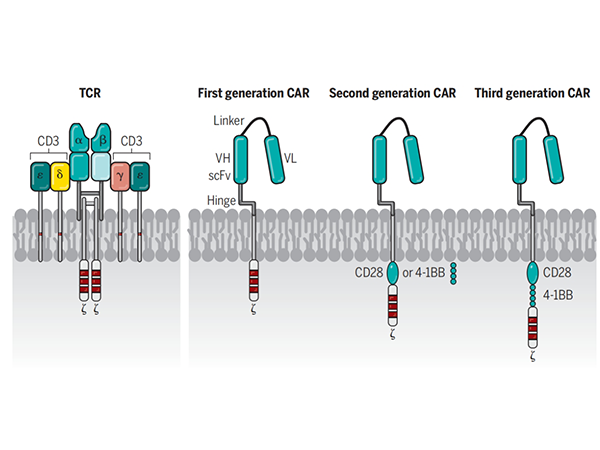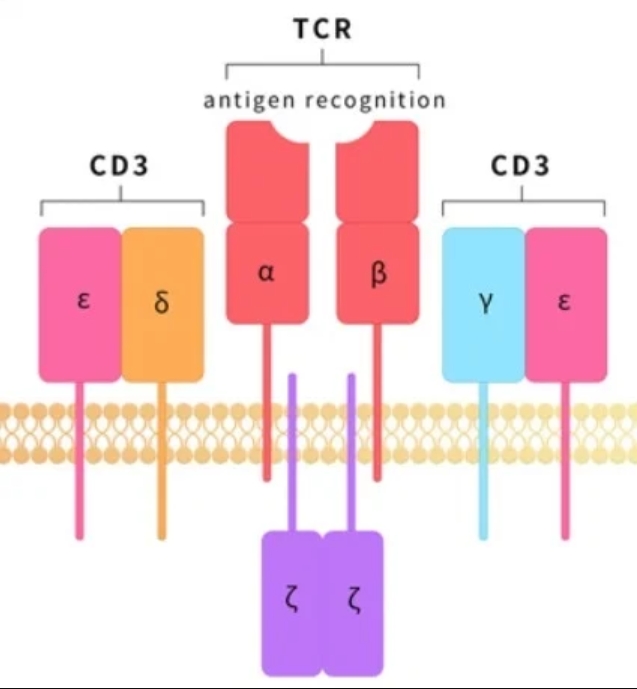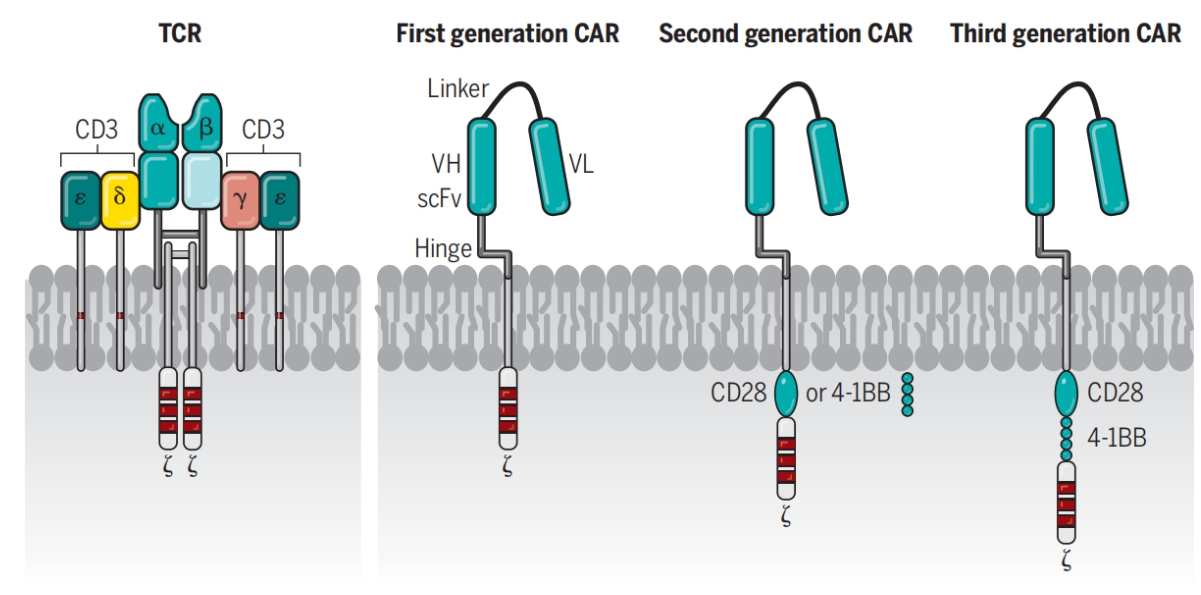CD3: From the Foundation of the Immune System to the Frontier of Cancer Treatment as a Bispecific Antibody Target

In the intricate operation of the human immune system, CD3 serves as a pivotal player. It is not only a core participant in the functions of T cells but also a hot target in the current field of cancer immunotherapy. A deep understanding of the mysteries of CD3 holds great significance for unlocking more effective cancer treatment therapies.
The Protein Structure and Signal Transduction of CD3
CD3 is a multimeric protein complex composed of four polypeptide chains, namely ε, γ, δ, and ζ. It functions in the form of three pairs of dimers, εγ, εδ, and ζζ. CD3 is tightly and non-covalently bound to the T cell receptor (TCR) and is a characteristic marker of the T cell lineage. Structurally, CD3 contains an N-terminal extracellular region, a transmembrane domain, and a cytoplasmic tail region with an immunoreceptor tyrosine-based activation motif (ITAM). Among them, the extracellular domains of CD3 ε, γ, and δ contain lg-like domains and belong to the immunoglobulin superfamily.
CD3 plays an irreplaceable role in the activation process of T cells. The TCR - CD3 complex is expressed on the surface of T cells. After the TCR - αβ specifically recognizes the homologous peptide antigen bound to the MHC molecule, the CD3 subunits transmit the signal into the cytoplasm, activating a series of signal transduction events. For example, Lck can phosphorylate ITAM to initiate signal transduction. ZAP - 70 interacts with phosphorylated CD3 to activate the downstream cascade reaction. Nck, WASP, etc. are also involved, jointly regulating the activation and differentiation of T cells. However, how the TCR - CD3 complex produces diverse results according to different stimuli remains a direction of exploration for researchers. It is speculated that it is related to the recruitment of different interacting proteins.

The Significance of CD3 in Disease Diagnosis and Treatment
In the field of diseases, CD3 is an important marker for the classification of malignant lymphomas and leukemias (T cell tumors). In diseases such as celiac disease, lymphocytic colitis, and collagenous colitis, it can also be used to identify T cells. It is worth noting that the susceptibility to type I diabetes is associated with the CD3 ε locus, and anti-CD3 antibodies have shown potential in improving the symptoms of type I diabetes and other autoimmune diseases. Systemic lupus erythematosus (SLE), on the other hand, is associated with a deficiency in the CD3 ζ polypeptide chain.
The Research and Development Status of CD3-Targeted Bispecific Antibodies
Currently, among CD3-targeted drugs, the research on bispecific antibodies is the most intense. CD3 bispecific antibodies can guide CD3 + T cells to precisely kill cancer cells, playing a key role in cancer immunotherapy. At present, several CD3 bispecific antibodies have been approved for the treatment of hematological malignancies. For example, Blinatumomab from Amgen/Baiji Shenzhou is the first CD3 bispecific antibody to be approved for marketing and is also the first drug using the BiTE technology. However, due to the lack of a long-acting design, its administration is inconvenient, and its sales growth has been relatively slow. In the past year, Epcoritamab from AbbVie, Glofitamab and Mosunetuzumab from Roche, Teclistamab from Johnson & Johnson, etc. have been successively approved, further enriching the treatment options for hematological malignancies.

In addition to the approved drugs, many pharmaceutical companies are actively laying out the R&D pipelines of CD3 bispecific antibodies. The popular targets combined with CD3 include CD20, BCMA, CD19, EGFR, etc. Pfizer and Johnson & Johnson's bispecific antibodies for multiple myeloma have been submitted for marketing applications. Talquetamab from Johnson & Johnson, as the only GPRC5D-targeted drug that has entered phase 3, has shown good efficacy. The objective response rate (ORR) in the treatment of patients with more than three lines of treatment reaches 74.1%.
Clinical research is also exploring the application of CD3 bispecific antibodies in the treatment of solid tumors, mainly focusing on classic tumor-associated antigen (TAA) targets such as CEA, EGFR, EpCAM, HER2, and PSMA. However, the R&D of CD3 bispecific antibodies faces many challenges. In terms of safety, cytokine release syndrome (CRS) and neurological toxicity are relatively common, and it is necessary to reasonably regulate the affinity of bispecific antibodies to the CD3 antigen. In the treatment of solid tumors, there are obstacles such as off-target toxicity, insufficient infiltration of T cells, and immunosuppression in the tumor microenvironment. Nevertheless, researchers are actively seeking solutions, such as selecting TAAs that are specifically expressed in tumors, pre-treating the tumor microenvironment, and targeting immunosuppressive cells, etc., to continuously strive to overcome these difficulties.
As a bispecific antibody target, CD3 has broad prospects but also many challenges in the field of cancer treatment. With the deepening of research and the advancement of technology, it is believed that in the future, CD3-targeted bispecific antibodies will bring new hope to more cancer patients and promote cancer treatment to a new stage.
Product Information
| Gatalog Num | Product Name | Product Parameters | Price |
| UA010199 | CD3 epsilon Fc Chimera Protein, Human | Host : Human | $560 |
| Expression System : HEK293 | |||
| Conjugation : Unconjugated | |||
| UA010173 | CD3 epsilon Fc Chimera Protein, Cynomolgus | Host : Cynomolgus | $540 |
| Expression System : HEK293 | |||
| Conjugation : Unconjugated | |||
| S0B1801 | Pacific Blue Mouse Anti-Mouse CD3ε Antibody (S-R384) | Host : Mouse | $380 |
| Conjugation : Pacific Blue | |||
| S0B0661 | Invivo anti-mouse CD3ε Recombinant mAb | Host : Mouse | $150 |
| Conjugation : Unconjugated | |||
| S0B1766 | FITC Mouse Anti-Mouse CD3ε Antibody (S-R384) | Host : Mouse | $110 |
| Conjugation : FITC | |||
| S0B1056 | CD3ε Recombinant Rabbit mAb (S-300-125) | Host : Rabbit | Inquiry |
| Conjugation : Unconjugated | |||
| S0B5200 | Biotin Mouse Anti-Human CD3 Antibody (S-R531) | Host : Mouse | $100 |
| Conjugation : Biotin | |||
| S0C2023 | PD-1, T cell, Cytotoxic T cell and Macrophage Marker (PD-1, CD3 epsilon, CD8α, CD68) Antibody Panel | Conjugation : Unconjugated | $400 |
| S0C2010 | Microglia, Mature Neuron and Astrocyte Marker (Iba1, NeuN, GFAP) Antibody Panel | Host : Rabbit | $300 |
| Conjugation : Unconjugated | |||
| S0A1136 | Mouse CD3 epsilon Protein, hFc tag | Host : Mouse | $225 |
| Expression System : HEK293 | |||
| Conjugation : Unconjugated | |||
| S0B2258P | CD3 epsilon Mouse mAb,PBS Only (SDT-570-36) | Host : Mouse | Inquiry |
| Conjugation : Unconjugated | |||
| S0B2258P | CD3 epsilon Mouse mAb,PBS Only (SDT-570-36) | Host : Mouse | Inquiry |
| Conjugation : Unconjugated | |||
| S0B2132 | CD3 epsilon Recombinant Rabbit mAb (SDT-241-49) | Host : Rabbit | $880 |
| S0B2132P | CD3 epsilon Recombinant Rabbit mAb,PBS Only (SDT-241-49) | Host : Rabbit | Inquiry |
| S0B0215 | CD3 epsilon Recombinant Rabbit mAb (Alexa Fluor® 647 Conjugate) (S-241-49) | Host : Rabbit | Inquiry |
| Conjugation : Alexa Fluor® 647 | |||
| S0B0217 | CD3 epsilon Recombinant Rabbit mAb (Alexa Fluor® 594 Conjugate) (S-241-49) | Host : Rabbit | Inquiry |
| Conjugation : Alexa Fluor® 594 | |||
| S0B0212 | CD3 epsilon Recombinant Rabbit mAb (Alexa Fluor® 555 Conjugate) (S-241-49) | Host : Rabbit | Inquiry |
| Conjugation : Alexa Fluor® 555 | |||
| S0B1610 | CD3 epsilon Recombinant Rabbit mAb (Alexa Fluor® 488 Conjugate) (SDT-241-49) | Host : Rabbit | Inquiry |
| Conjugation : Alexa Fluor® 488 | |||
| S0B2196 | S-RMab® CD3 epsilon Recombinant Rabbit mAb (SDT-R137) | Host : Rabbit | $350 |
| S0B2196P | S-RMab® CD3 epsilon Recombinant Rabbit mAb,PBS Only (SDT-R137) | Host : Rabbit | Inquiry |




